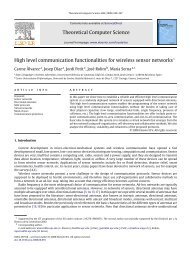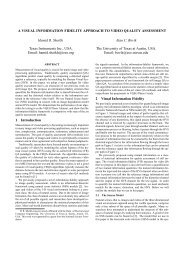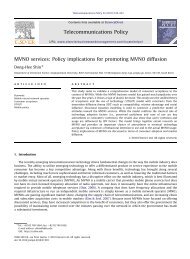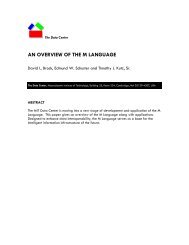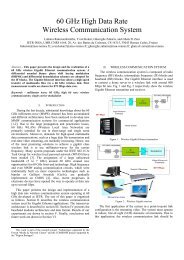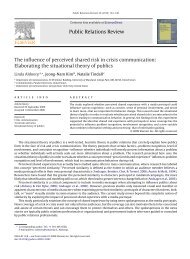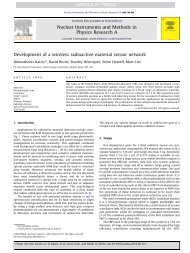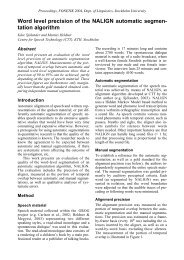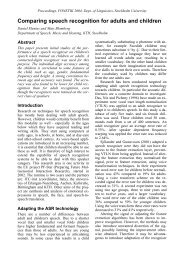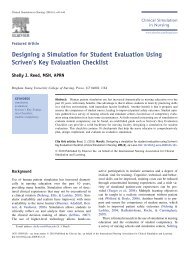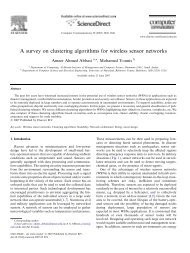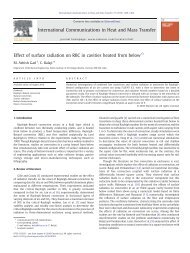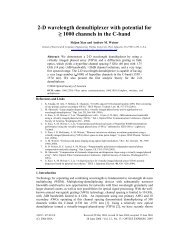BLR: beacon-less routing algorithm for mobile ad hoc networks
BLR: beacon-less routing algorithm for mobile ad hoc networks
BLR: beacon-less routing algorithm for mobile ad hoc networks
You also want an ePaper? Increase the reach of your titles
YUMPU automatically turns print PDFs into web optimized ePapers that Google loves.
<strong>BLR</strong>: <strong>beacon</strong>-<strong>less</strong> <strong>routing</strong> <strong>algorithm</strong> <strong>for</strong> <strong>mobile</strong> <strong>ad</strong> <strong>hoc</strong> <strong>networks</strong><br />
Marc Heissenbüttel*, Torsten Braun, Thomas Bernoulli, Markus Wälchli<br />
Institute of Computer Science and Applied Mathematics, University of Bern, Bern, Switzerland<br />
Abstract<br />
Routing of packets in <strong>mobile</strong> <strong>ad</strong> <strong>hoc</strong> <strong>networks</strong> with a large number of nodes or with high mobility is a very difficult task and current<br />
<strong>routing</strong> protocols do not really scale well with these scenarios. The <strong>beacon</strong>-<strong>less</strong> <strong>routing</strong> <strong>algorithm</strong> (<strong>BLR</strong>) presented in this paper is a<br />
<strong>routing</strong> protocol that makes use of location in<strong>for</strong>mation to reduce <strong>routing</strong> overhe<strong>ad</strong>. However, unlike other position-based <strong>routing</strong><br />
protocols, <strong>BLR</strong> does not require nodes to periodically bro<strong>ad</strong>cast Hello-messages (called <strong>beacon</strong>ing), and thus avoids drawbacks such as<br />
extensive use of scarce battery-power, interferences with regular data transmission, and per<strong>for</strong>mance degr<strong>ad</strong>ation. <strong>BLR</strong> selects a<br />
<strong>for</strong>warding node in a distributed manner among all its neighboring nodes with having in<strong>for</strong>mation neither about their positions nor even<br />
about their existence. Data packets are bro<strong>ad</strong>casted and the protocol takes care that just one of the receiving nodes <strong>for</strong>wards the packet.<br />
Optimized <strong>for</strong>warding is achieved by applying a concept of dynamic <strong>for</strong>warding delay. Consequently, the node that computes the<br />
shortest <strong>for</strong>warding delay relays the packet first. This <strong>for</strong>warding is detected by the other nodes and suppresses them to relay the same<br />
packet any further. Analytical results and simulation experiments indicate that <strong>BLR</strong> provides efficient and robust <strong>routing</strong> in highly<br />
dynamic <strong>mobile</strong> <strong>ad</strong> <strong>hoc</strong> <strong>networks</strong>.<br />
q 2004 Elsevier B.V. All rights reserved.<br />
Keywords: Mobile <strong>ad</strong> <strong>hoc</strong> <strong>networks</strong>; Wire<strong>less</strong> communication; Ad <strong>hoc</strong> <strong>routing</strong> protocols; Position-based <strong>routing</strong>; Energy efficient <strong>routing</strong><br />
1. Introduction<br />
A wire<strong>less</strong> <strong>mobile</strong> <strong>ad</strong> <strong>hoc</strong> network operates without any<br />
centralized <strong>ad</strong>ministration and does not rely on any fixed<br />
infrastructure. Inste<strong>ad</strong>, the network is completely sel<strong>for</strong>ganizing<br />
and the communication is maintained on a peerto-peer<br />
basis between the <strong>mobile</strong> hosts. If two hosts that<br />
wish to communicate are not within range, other intermediate<br />
nodes act as relay stations.<br />
Due to the mobility of the nodes, changes to the network<br />
topology may be frequent and unpredictable. Furthermore,<br />
nodes may suddenly be switched on/off, causing new links<br />
to appear and established links to vanish. Routing in such a<br />
dynamic environment is a difficult task and has been subject<br />
of extensive research over the past years. Several <strong>routing</strong><br />
protocols have been defined within MANET [1] working<br />
group of IETF such as AODV [2], DSR [3], TORA [4],<br />
DSDV [5], TBRPF [6], OLSR [7], ZRP [8], FSR [9],<br />
LANDMAR [10]. These protocols either use a kind of<br />
flooding to detect routes on-demand or pro-actively<br />
maintain <strong>routing</strong> in<strong>for</strong>mation at each node. Generally,<br />
* Corresponding author.<br />
E-mail <strong>ad</strong>dresses: heissen@iam.unibe.ch (M. Heissenbüttel); braun@<br />
iam.unibe.ch (T. Braun); bernoull@iam.unibe.ch (T. Bernoulli); waelchli@<br />
iam.unibe.ch (M. Wälchli).<br />
0140-3664/$ - see front matter q 2004 Elsevier B.V. All rights reserved.<br />
doi:10.1016/j.comcom.2004.01.012<br />
Computer Communications 27 (2004) 1076–1086<br />
www.elsevier.com/locate/comcom<br />
they are considered not to scale in <strong>networks</strong> with more<br />
than several hundred nodes. Unlike these topology-based<br />
<strong>routing</strong> protocols, which do not make use of location<br />
in<strong>for</strong>mation, position-based (also called geometric or<br />
directional <strong>routing</strong>) protocols try to optimize <strong>routing</strong> by<br />
making use of geographical in<strong>for</strong>mation available at each<br />
node (GFG [11], GPSR [12], LAR [13], TRR [14], AFR<br />
[15], EASE [16], DREAM [17]). Every node is aware of its<br />
own position and is notified of its neighbors’ positions<br />
through the exchange of <strong>beacon</strong>s (small packets bro<strong>ad</strong>casted<br />
by the neighbors to announce their position). Additionally, a<br />
node is able to determine the location of the destination<br />
through a location management scheme.<br />
This <strong>ad</strong>ditional position-in<strong>for</strong>mation allows improving<br />
<strong>routing</strong> significantly and, thus, increases the network<br />
scalability in terms of network size, mobility, and traffic.<br />
Position-based <strong>routing</strong> is likely one of the enablers <strong>for</strong> largescale<br />
<strong>mobile</strong> <strong>ad</strong> <strong>hoc</strong> <strong>networks</strong>, where the number of nodes<br />
can potentially reach several thousands as considered in the<br />
Terminodes project [18]. (Even though, it was shown in Ref.<br />
[19] that the per node capacity tends to zero as the number<br />
of nodes goes to infinity <strong>for</strong> certain network and traffic<br />
models.)<br />
The <strong>beacon</strong>-<strong>less</strong> <strong>routing</strong> <strong>algorithm</strong> (<strong>BLR</strong>) described in<br />
this paper per<strong>for</strong>ms <strong>routing</strong> in a distributed manner without
in<strong>for</strong>mation about neighboring nodes. If a node has a packet<br />
to send, it bro<strong>ad</strong>casts the packet and every neighboring node<br />
receives it. The protocol takes care that just one of these<br />
nodes relays the packet. This is accomplished by computing<br />
a dynamic <strong>for</strong>warding delay (DFD) at each node depending<br />
on its position relative to the previous and the destination<br />
node. The node located at the ‘optimal’ position introduces<br />
the shortest delay and thus transmits the packet first. Other<br />
nodes recognize the occurrence of the relaying and cancel<br />
their scheduled transmission of the same packet. Avoiding<br />
periodical transmission of <strong>beacon</strong>s provides many <strong>ad</strong>vantages,<br />
such as conserving scarce battery power and avoiding<br />
interferences with regular data transmission. To ensure that<br />
all nodes detect the <strong>for</strong>warding, only nodes within a certain<br />
area apply DFD and take part in the contention to <strong>for</strong>ward<br />
the packet.<br />
The remainder of this paper is organized as follows. First,<br />
an overview of existing position-based <strong>routing</strong> protocols is<br />
given. The <strong>routing</strong> <strong>algorithm</strong> <strong>BLR</strong> is introduced in Section 3<br />
and also some variations and optimizations are discussed. In<br />
Section 4, the basic greedy <strong>algorithm</strong> is evaluated<br />
analytically. Per<strong>for</strong>mance and behavior of <strong>BLR</strong> are<br />
evaluated in Section 5 through simulations and compared<br />
to other position-based <strong>routing</strong> <strong>algorithm</strong>s. Finally, Sections<br />
6 and 7 conclude this paper.<br />
2. Related work<br />
Most of the position-based <strong>routing</strong> <strong>algorithm</strong>s do not<br />
require the establishment of any route prior to data<br />
transmission. A packet can be sent in a greedy manner to<br />
any intermediate node into the direction of its destination,<br />
making almost state<strong>less</strong> <strong>routing</strong> feasible. (Exceptions are<br />
LAR [13] and DREAM [17] where location in<strong>for</strong>mation is<br />
used in order to reduce flooding <strong>for</strong> finding a route to the<br />
destination.) Nodes neither have to maintain installed routes<br />
nor store <strong>routing</strong> tables. Position-based <strong>routing</strong> protocols<br />
proposed in the literature mainly differ in the way they<br />
select the next hop among the neighboring nodes and in the<br />
recovery strategy in case the greedy <strong>for</strong>warding fails.<br />
(Overviews can be found in Refs. [20,21].) A further<br />
<strong>ad</strong>vantage is that position-based <strong>routing</strong> naturally supports<br />
geocasting [22–24].<br />
The first position-based <strong>routing</strong> protocols (MFR [25],<br />
NFP [26], RPM [27]) were alre<strong>ad</strong>y proposed in the 1980s <strong>for</strong><br />
packet r<strong>ad</strong>io <strong>networks</strong> and were lately rediscovered <strong>for</strong><br />
<strong>mobile</strong> <strong>ad</strong> <strong>hoc</strong> <strong>networks</strong>. These approaches are based on the<br />
notion of the term progress P: Progress is defined as the<br />
projection of the distance traveled over the last hop from P to<br />
any node A onto the line from P to the final destination D:<br />
MFR [25] was introduced trying to minimize the number of<br />
hops by selecting the node with the largest progress from the<br />
neighbors (A in Fig. 1). Under the assumption that nodes are<br />
able to <strong>ad</strong>just their transmission power, NFP was proposed in<br />
[26] in order to minimize the interference with other nodes<br />
M. Heissenbüttel et al. / Computer Communications 27 (2004) 1076–1086 1077<br />
Fig. 1. Forwarding strategies.<br />
and the overall power consumption by transmitting to the<br />
nearest node with <strong>for</strong>ward progress (B in Fig. 1). In Ref. [28],<br />
an approach very similar to MFR is introduced where the<br />
packet is <strong>for</strong>warded to the nearest node among the<br />
neighboring nodes, which are closer to the destination.<br />
The basic greedy <strong>algorithm</strong>s described above are inherently<br />
loop-free, but may fail to find a path even if there exists one,<br />
e.g. in the case a packet gets stuck at a node that does not have<br />
a neighbor closer to the destination or with <strong>for</strong>ward progress.<br />
Compass <strong>routing</strong> <strong>algorithm</strong>s were introduced in Ref. [29]<br />
where the <strong>for</strong>warding decision is based on the angles<br />
between nodes. A packet is <strong>for</strong>warded to the neighboring<br />
node minimizing the angle between itself, the previous<br />
node, and the destination (e.g. B in Fig. 1). Randomized<br />
compass [29] or greedy compass [30] are further variations<br />
of compass <strong>routing</strong>. With compass <strong>algorithm</strong>s, a packet<br />
cannot get stuck anymore, but they do only guarantee loopfreedom<br />
<strong>for</strong> certain kind of network graphs.<br />
GFG [11], GPSR [12], AFR [15] and GRA [31] try to<br />
overcome these drawbacks by applying greedy loop-free<br />
<strong>for</strong>warding combined with a recovery strategy if a packet<br />
gets stuck.<br />
In all these position-based <strong>routing</strong> approaches, the<br />
minimum in<strong>for</strong>mation a node must have to make useful<br />
<strong>routing</strong> decisions is its position (provided by GPS, Galileo,<br />
etc.), the position of its neighbors (through <strong>beacon</strong>ing), and<br />
the final destination’s location (e.g. VHR [32], GLS [33,34]).<br />
The drawbacks of <strong>beacon</strong>ing can be bro<strong>ad</strong>ly classified in<br />
two categories. The first category comprises drawbacks<br />
referring to energy consumption of <strong>beacon</strong>ing on a physical<br />
level. Beaconing is the proactive component of positionbased<br />
<strong>routing</strong> and thus occurs independently of actual data<br />
traffic. It uses scarce battery-power <strong>for</strong> transmitting,<br />
receiving, and processing of <strong>beacon</strong>s and also disturbs<br />
sleep cycles of nodes. (It was shown [35,36] that the ratio of<br />
sending/receiving/idle listening is in the order of 2/1.5/1<br />
<strong>for</strong> actual WaveLAN cards, i.e. substantial energy may only<br />
be saved in sleep modes. Even though the <strong>ad</strong>ditional cost of<br />
transmitting <strong>beacon</strong>s is almost negligible, <strong>beacon</strong>ing
1078<br />
neverthe<strong>less</strong> interrupts sleep cycles.) The second category<br />
consists of drawbacks on the MAC- and network-layer.<br />
First, due to the periodical bro<strong>ad</strong>cast of <strong>beacon</strong>s, collisions<br />
with data packets are likely to occur. Second, the <strong>routing</strong><br />
<strong>algorithm</strong> operates on the topology as perceived through the<br />
position-in<strong>for</strong>mation provided by <strong>beacon</strong>s. However, this<br />
in<strong>for</strong>mation may be outdated or inconsistent causing the<br />
<strong>algorithm</strong>s to take suboptimal decisions. For example, a<br />
node (i.e. the <strong>routing</strong> protocol) chooses a node as next hop<br />
from its neighbor table even though this node has<br />
meanwhile left its transmission range. Even in the absence<br />
of any movement, a neighboring node may only be<br />
reachable every once a while because of time-varying<br />
transmission ranges due to changing SINR (signal to<br />
interference and noise ratio). In both cases, the MAClayer<br />
is unable to deliver the packet. Depending on the<br />
implementation, the MAC-layer tries to retransmit the<br />
packet several times after a time-out (e.g. the default value<br />
is seven times in 802.11) and only now notifies the network<br />
layer of the failed <strong>for</strong>warding. The network layer is then<br />
responsible to select another next hop. Preliminary results<br />
(not shown in this paper) obtained by simulations show that<br />
these effects cause a strong degr<strong>ad</strong>ation of the per<strong>for</strong>mance<br />
of the network in terms of delay and packet-delivery ratio.<br />
Lately, a new class of position-based <strong>routing</strong> <strong>algorithm</strong>s<br />
were introduced (<strong>BLR</strong> [37] 1 , CBF [38], IGF [39]) that avoid<br />
having <strong>beacon</strong>s transmitted periodically and, hence, eliminating<br />
the belonging drawbacks. The mechanism that<br />
allows selecting one neighbor as next hop in a completely<br />
distributed manner without having knowledge of the<br />
neighboring nodes is achieved in all the papers by applying<br />
the concept of DFD. They mainly differ in the investigated<br />
aspects. In CBF [38] and IGF [39], the focus is on the<br />
integration of the <strong>routing</strong> protocol with the MAC-layer,<br />
namely the IEEE 802.11 protocol. Heissenbüttel and Braun<br />
[37] discuss several optimizations to the basic greedy<br />
scheme and also derives analytical properties and limitations<br />
of this new class of protocols.<br />
The main drawbacks of these protocols are that greedy<br />
<strong>for</strong>warding can be applied <strong>less</strong> often than in other positionbased<br />
<strong>algorithm</strong>s due to restrictions on the position of the<br />
next node. Some <strong>ad</strong>vantages of <strong>beacon</strong>-<strong>less</strong> <strong>algorithm</strong>s are<br />
lost in case a recovery procedure needs to be initiated.<br />
There<strong>for</strong>e, these <strong>algorithm</strong>s per<strong>for</strong>m best in dense <strong>networks</strong><br />
where they operate in greedy mode most of the time.<br />
3. The <strong>BLR</strong> protocol (<strong>beacon</strong>-<strong>less</strong> <strong>routing</strong>)<br />
3.1. Assumptions<br />
Nodes are aware of their own position by means of GPS,<br />
Galileo, or any other positioning service [40]. GPS and<br />
Galileo allow nodes to determine their longitude, latitude,<br />
1 The paper is an earlier version of the present paper.<br />
M. Heissenbüttel et al. / Computer Communications 27 (2004) 1076–1086<br />
and altitude depending on the number of satellites in the<br />
line-of-sight. (For reasons of simplicity, the altitude of<br />
nodes is not considered in this paper.) Furthermore, there is<br />
a mechanism that enables the source to detect accurately<br />
enough the destination node’s position [32–34]. But,<br />
opposed to ‘conventional’ position-based <strong>routing</strong> <strong>algorithm</strong>s<br />
described in Section 2, no <strong>beacon</strong>ing mechanism is<br />
used to provide nodes with topological in<strong>for</strong>mation about<br />
their neighbors.<br />
Furthermore, there are two system-wide parameters,<br />
which are known by all the nodes. Max_delay indicates the<br />
maximum delay a packet can experience per hop, and a<br />
maximum transmission r<strong>ad</strong>ius r: The network is modeled<br />
with the unit disk graph where nodes may communicate<br />
directly if their distance is smaller than the fixed r: As a<br />
consequence, all links are bidirectional and antennas are<br />
omnidirectional.<br />
3.2. Basic principle<br />
If a source node has a data packet to send, it first<br />
determines the position of the destination and stores these<br />
geographical coordinates along with its own current<br />
position in the he<strong>ad</strong>er of the packet. All intermediate<br />
nodes just replace the previous node’s position by their<br />
current position in the he<strong>ad</strong>er be<strong>for</strong>e <strong>for</strong>warding the packet.<br />
Since a node does not possess knowledge of neighboring<br />
nodes, it bro<strong>ad</strong>casts the packet to all neighboring nodes.<br />
Upon the reception of a packet, the only available<br />
in<strong>for</strong>mation an intermediate node has is its own position<br />
and the position of the previous and the destination node,<br />
extracted from the packet he<strong>ad</strong>er. Thus, a node can easily<br />
derive if it is located within a specific area relative to the<br />
previous transmitting node.<br />
Nodes located within this <strong>for</strong>warding area apply DFD<br />
prior to relaying the packet, whereas nodes outside this<br />
area drop the received packet. The value of the DFD<br />
[0, Max_Delay ] depends on the relative position coordinates<br />
of current, previous, and destination node. Eventually,<br />
the node that computed the shortest DFD <strong>for</strong>wards the<br />
packet first. Every node in the <strong>for</strong>warding area detects the<br />
further relaying of the packet and cancels its scheduled<br />
transmission of the same packet. Furthermore, passive<br />
acknowledgments are used (cp. [41]). The previous<br />
transmitting node also detects the further relaying of the<br />
packet and thus concludes that it was successfully received<br />
by another node. Thereby, acknowledgments on the MAClayer<br />
can be avoided. (For example in IEEE 802.11, there are<br />
even no acknowledgments provided <strong>for</strong> bro<strong>ad</strong>cast packets.)<br />
The <strong>algorithm</strong> continues until the destination is reached.<br />
The only node that has to send an acknowledgement is the<br />
destination node since it does not relay the packet any<br />
further. To cope with position inaccuracies of the destination<br />
position, an <strong>ad</strong>apted and restricted reactive protocol<br />
based on AODV [2] is applied in the vicinity of the<br />
destination (Section 3.6).
3.2.1. Forwarding areas<br />
Forwarding areas are relative to the relaying node and<br />
may be basically of any shape provided that all nodes within<br />
the area are within each others transmission range. (This<br />
requirement may be dropped in cases where packet<br />
duplication is desired to increase redundancy and resilience.)<br />
An infinite number of areas fulfill this requirement.<br />
However, the <strong>for</strong>warding area should be large in order to<br />
increase the probability of finding a node within the area.<br />
Furthermore, another objective of the area is to favor nodes<br />
that are located near the border of the transmission range,<br />
which enables large progress per transmission and thus<br />
reduces the number of hops to the destination.<br />
In Fig. 2, three possible areas are depicted, namely a<br />
sector, a Reuleaux triangle and a circle, which all fulfill the<br />
condition of mutual possible reception <strong>for</strong> nodes located<br />
within these areas. For the sector and the Reuleaux triangle,<br />
this is achieved by an apex angle of 608, which limits the<br />
distance of two arbitrarily placed nodes to the transmission<br />
range r: The circle just has a diameter of r: The numbers in<br />
Fig. 2 indicate the ratio covered with the corresponding<br />
<strong>for</strong>warding area to the overall transmission area. We will see<br />
in Section 4 that this value and as well as the shape of the<br />
area have a strong impact on the behavior of the <strong>algorithm</strong>.<br />
3.2.2. Delay functions<br />
The function that computes DFD timer values of<br />
individual nodes may apply different <strong>for</strong>warding policies.<br />
Each node within the <strong>for</strong>warding area first determines<br />
different parameters, such as its progress p towards the<br />
destination with respect to the last hop and its distance<br />
d from the line S–D (cf. Fig. 1). From these values the<br />
node derives the DFD value Add_delay in the interval<br />
[0, Max_delay ].<br />
Three different delay functions are described below. The<br />
function in Eq. (1) implements basically MFR [25]. A node<br />
with <strong>less</strong> progress introduces a larger delay than a node with<br />
more progress. Consequently, the node with the most<br />
progress within the <strong>for</strong>warding area <strong>for</strong>wards the packet at<br />
M. Heissenbüttel et al. / Computer Communications 27 (2004) 1076–1086 1079<br />
first in order to minimize the number of hops to the<br />
destination.<br />
Add_delay ¼ Max_delay<br />
r 2 p<br />
r<br />
Add_delay ¼ Max_delay p<br />
r<br />
Add_delay ¼ Max_delay<br />
ffiffiffiffiffiffiffiffiffi<br />
e p2 þ d2 p !<br />
e<br />
The function in Eq. (2) implements a slightly modified<br />
NFP [26]. NFP is not directly applicable since a node does<br />
not know which neighbor is the nearest. The node with the<br />
least progress introduces the shortest delay and <strong>for</strong>wards the<br />
packet. The objective is to reduce energy consumption and<br />
increase the number of possible simultaneous transmissions<br />
which increases the overall capacity of the network as<br />
shown in Ref. [26].<br />
Inste<strong>ad</strong> of these basic functions, more <strong>ad</strong>vanced DFD<br />
functions are possible that not only take into account the<br />
progress of a node but as well the distance to the previous<br />
node. If progress is used as the only parameter, nodes<br />
located far away from the direct line S 2 D to the<br />
destination may be favored over a node with only little<br />
<strong>less</strong> progress but in almost straight direction towards the<br />
destination. Furthermore, it was shown in Ref. [42] that<br />
exponentially distributed random timers can further reduce<br />
the number of responses compared to uni<strong>for</strong>mly distributed<br />
timers. In Eq. (3), these observations are combined to a<br />
more <strong>ad</strong>vanced DFD function.<br />
In Fig. 3, the <strong>ad</strong>ditional delay introduced by Eq. (3) <strong>for</strong><br />
all nodes with <strong>for</strong>ward progress is depicted. Nodes close to<br />
the previous node introduce a short delay, whereas nodes<br />
located farther away compute a higher DFD timer.<br />
3.3. Unicast packets<br />
Bro<strong>ad</strong>casting of all data packets has several drawbacks.<br />
First, bro<strong>ad</strong>cast packets need to be passed to the protocol<br />
stack at each receiving node and cannot be dropped at the<br />
network interface card. Furthermore, data packets are<br />
Fig. 2. Different <strong>for</strong>warding areas. Fig. 3. Additional delay vs. progress vs. distance.<br />
ð1Þ<br />
ð2Þ<br />
ð3Þ
1080<br />
bro<strong>ad</strong>casted at full transmission power, even in case the<br />
<strong>for</strong>warding node is located very close. There<strong>for</strong>e, the<br />
possible interference range is increased and inhibits other<br />
simultaneous transmissions in the vicinity. These two facts<br />
are a major source of energy consumption. Furthermore,<br />
bro<strong>ad</strong>cast packets are transmitted at 2 Mbps while unicast<br />
packets may be transmitted at 11 Mbps using IEEE 802.11b.<br />
In order to circumvent these drawbacks, an option in <strong>BLR</strong> is<br />
not to bro<strong>ad</strong>cast all data packet, but to transmit most of the<br />
packets via unicast with <strong>ad</strong>justed transmission power.<br />
After a node has detected through passive acknowledgment<br />
the successful reception of the transmitted packet,<br />
it is aware of the <strong>for</strong>warding node’s position. Thus, the node<br />
may <strong>ad</strong>just its transmission power and send the subsequent<br />
packets via unicast to the node, which relayed the bro<strong>ad</strong>cast<br />
packet. Due to the mobility of the nodes, a node located at a<br />
better position towards the destination may enter into the<br />
node’s transmission range. In order to be able to detect this<br />
new node, a packet is bro<strong>ad</strong>casted at full power again after a<br />
certain time called Beacon_Interval. After bro<strong>ad</strong>casting a<br />
packet at full power, new neighboring nodes may be<br />
detected. However, this restriction applies as well <strong>for</strong><br />
‘conventional’ <strong>beacon</strong>ing mechanisms, where a node<br />
located at a better position can only be detected after it<br />
announces its position by bro<strong>ad</strong>casting a <strong>beacon</strong>. Hence, an<br />
optimized <strong>routing</strong> path is determined after the <strong>beacon</strong><br />
interval.<br />
Packets transmitted via unicast are <strong>for</strong>warded immediately<br />
without introducing an <strong>ad</strong>ditional delay. Furthermore,<br />
unicast packets are explicitly acknowledged on the MAClayer.<br />
In case a node is no longer able to deliver packets via<br />
unicast because, e.g. the downstream node was switched off,<br />
it transmits the next packet again in bro<strong>ad</strong>cast mode to<br />
detect other nodes towards the destination. Similarly, if a<br />
node detects its downstream node to be moving out of its<br />
transmission range, a packet is transmitted at full power<br />
even be<strong>for</strong>e Beacon_Interval in order to avoid unnecessary<br />
interruptions of links with ongoing data transmissions.<br />
Velocity and direction of movement are stored in the packet<br />
to estimate time of link break.<br />
In order to reduce the delay in case the <strong>ad</strong>dressed unicast<br />
node is not reachable anymore, which would cause timeouts<br />
and retransmissions, nodes may operate in promiscuous<br />
mode, i.e. they process as well unicast packets, which are<br />
not destined <strong>for</strong> them. All nodes located in the <strong>for</strong>warding<br />
area, which detect that a unicast packet was not acknowledged<br />
or relayed within a certain time, assume that the<br />
unicast delivery failed and apply DFD as usual. There is a<br />
tr<strong>ad</strong>e-off with energy consumption, since operating nodes in<br />
promiscuous mode consumes a lot of battery power too.<br />
3.4. Aggregation of paths<br />
In order to be able to take <strong>ad</strong>vantage from transmitting<br />
unicast data packets, different paths through one node are<br />
aggregated. For that, each node keeps a table of all<br />
M. Heissenbüttel et al. / Computer Communications 27 (2004) 1076–1086<br />
neighboring nodes and their respective positions, which it<br />
gathered from overheard packets and passive acknowledgements.<br />
A node may <strong>for</strong>ward a packet via unicast inste<strong>ad</strong><br />
of bro<strong>ad</strong>casting as soon it is aware of any neighbor that is<br />
closer to the final destination. This can possibly le<strong>ad</strong> to a<br />
very suboptimal path since packets may be routed to distant<br />
nodes with little progress even if there are nodes located at<br />
much better positions. Another possibility to route the<br />
packet more directly towards the destination is to allow a<br />
node to transmit a packet only via unicast if the known<br />
neighbor is alre<strong>ad</strong>y located in the <strong>for</strong>warding area <strong>for</strong> that<br />
packet.<br />
3.5. Backup mode<br />
A node which does not detect through passive acknowledgement<br />
a <strong>for</strong>warding of data packets within Max_delay<br />
assumes an empty <strong>for</strong>warding area with no nodes. A<br />
recovery strategy is defined to deal with this situation. The<br />
node bro<strong>ad</strong>casts a short request and all neighboring nodes<br />
reply with a packet indicating their positions. If a node<br />
located closer to the destination replies, this node is chosen<br />
as the next hop. Otherwise, the actual node extracts a planar<br />
subgraph (e.g. Gabriel Graph) <strong>for</strong> its neighborhood and<br />
<strong>for</strong>wards the packet via unicast according to the right-hand<br />
rule (see e.g. AFR [15]). The extraction of the planar<br />
subgraph is necessary in order to prevent packets to enter a<br />
loop (actually this only applies <strong>for</strong> static <strong>networks</strong>). The<br />
position where the basic mode failed is stored in the packet<br />
he<strong>ad</strong>er. As soon as the packet arrives at a node located<br />
closer to the destination than where it entered the backup<br />
mode, it switches back to the basic greedy <strong>for</strong>warding again.<br />
3.6. Reactive local <strong>routing</strong> (RLR)<br />
In order to cope with inaccurate location in<strong>for</strong>mation, a<br />
reactive local <strong>routing</strong> <strong>algorithm</strong> (RLR) is applied in the<br />
vicinity of the destination. The reason <strong>for</strong> using a reactive<br />
protocol inste<strong>ad</strong> of a proactive as proposed in Terminodes<br />
Routing [14] is that proactive protocols require to transmit a<br />
list of neighbors in the <strong>beacon</strong>s. Especially in dense<br />
<strong>networks</strong> and with high transmission ranges, the number<br />
of neighbors can be large and hence significantly increase<br />
the size of the <strong>beacon</strong>s.<br />
RLR is initiated in case a node, other than the final<br />
destination node, which is within transmission range r of the<br />
destination coordinates, receives the packet and has no closer<br />
neighbor. RLR is a restricted and <strong>ad</strong>apted version of the<br />
standard AODV protocol [2]. The node bro<strong>ad</strong>casts six Route<br />
Requests (RREQs) <strong>for</strong> the final destination node with the<br />
destination coordinates of these RREQs in six directions<br />
separated by 608 and at twice the transmission range from the<br />
original destination coordinates. Thereby, the flooding and<br />
the propagation of the RREQs are limited. The destination<br />
node receives or at least overhears the RREQ and responds<br />
with a Route Reply (RREP). After the establishment of
the path to the destination, all subsequent packets are routed<br />
directly over this route. Especially if a node has a large<br />
number of neighbors, much <strong>less</strong> packets are transmitted with<br />
RLR as opposed to sending one RREQ with a limited TTL<br />
field, which would yield at least as many transmissions as<br />
there are nodes in the x-hop neighborhood.<br />
3.7. Node density<br />
Obviously, the <strong>BLR</strong> <strong>algorithm</strong> works best if it can<br />
operate most of the time in basic mode, i.e. if there is a<br />
rather high node density between the source and destination<br />
such that at least one node is located within the <strong>for</strong>warding<br />
area. (The same applies as well <strong>for</strong> most of the other<br />
position-based <strong>routing</strong> protocols, where greedy <strong>for</strong>warding<br />
fails in case there is no neighboring node closer to the<br />
destination, i.e. just the <strong>for</strong>warding area is larger.) This is<br />
often not the case due to obstacles or unpopulated areas<br />
in-between. However, some <strong>algorithm</strong>s (e.g. TRR [14],<br />
MABR [43]) try to provide a path from the source to the<br />
destination, probably not along the line of sight but with some<br />
detours, such that the node density is always high along this<br />
determined path. The packets are not directly routed to the<br />
position of the destination node, but to (perhaps several)<br />
intermediate coordinates. Packets are only routed between<br />
these intermediate geographical coordinates in a greedy<br />
manner. There<strong>for</strong>e, <strong>BLR</strong> may be <strong>ad</strong>vantageously integrated<br />
with these <strong>algorithm</strong>s. In Section 4, we will consider the<br />
impact of the node density, and also the transmission range r;<br />
on the <strong>algorithm</strong> analytically and through simulations.<br />
3.8. Practical considerations<br />
The strong assumptions of the unit-disc graph model with<br />
bidirectional links and disc-like transmission areas may not<br />
hold if real physical propagation patterns and r<strong>ad</strong>io devices<br />
are considered. Unidirectional links are likely to exist due to<br />
unequal SINR at the transmitting and receiving nodes.<br />
Transmission areas are highly asymmetrical due to<br />
obstacles between nodes and again due to unequal SINR,<br />
among others. Furthermore, these influences may not be<br />
static but vary over time. Because of these reasons, it is<br />
possible that a node within the <strong>for</strong>warding area does not<br />
detect the relaying of a packet by another node. Basically,<br />
one more copy of a packet is created <strong>for</strong> each node within<br />
the <strong>for</strong>warding area which does not detect the subsequent<br />
relaying by a next node, including the previous transmitting<br />
node. However, <strong>BLR</strong> does not introduce any <strong>ad</strong>ditional<br />
delay since if any node in the <strong>for</strong>warding area does receive a<br />
packet, it is <strong>for</strong>warded almost immediately. This is unlike in<br />
tr<strong>ad</strong>itional position-based <strong>routing</strong> protocols with <strong>beacon</strong>s<br />
where the current physical conditions have a strong impact<br />
on the delay due to the outdated or inconsistent neighbor<br />
tables as discussed in Section 2.<br />
Some packets may be transmitted via unicast at 11 Mbps<br />
and others are bro<strong>ad</strong>casted at 2 Mbps. It has to be taken into<br />
M. Heissenbüttel et al. / Computer Communications 27 (2004) 1076–1086 1081<br />
account that the neighbors, which receive these packets, are<br />
not the same due to the shorter transmission range at higher<br />
data rates. There<strong>for</strong>e, if DFD timers are computed using<br />
delay function (1) such that distant nodes relay the packet<br />
first, unicast packets likely have to be transmitted at 2 Mbps<br />
as well. This problem is mitigated by applying DFD with<br />
delay function (2) such that always a close node is chosen as<br />
next hop. Conventional position-based <strong>routing</strong> protocols<br />
with <strong>beacon</strong>s suffer from a similar effect since they apply<br />
<strong>for</strong>warding strategies trying to reduce the number of hops.<br />
Beacons are bro<strong>ad</strong>casted and, thus, are received at distant<br />
nodes which likely are not reachable by unicast packets at<br />
higher data rates.<br />
4. Analytical results<br />
4.1. Expected number of hops be<strong>for</strong>e basic mode fails<br />
We consider a multi-hop <strong>ad</strong> <strong>hoc</strong> network where nodes are<br />
distributed according to a two-dimensional homogenous<br />
Poisson point process, i.e. the number of nodes in a region is<br />
a random variable X depending only on the volume of the<br />
region. If n is the node density within the network (in<br />
number of nodes per square kilometer), then the probability<br />
that there are exactly k nodes appearing in a <strong>for</strong>warding area<br />
of size AFðrÞ; depending on the transmission range r; is<br />
given by<br />
PðX ¼ kÞ ¼e 2nA nA FðrÞ FðrÞÞ k<br />
ð4Þ<br />
k!<br />
This immediately yields the probability p that at least one<br />
node is located within the <strong>for</strong>warding area.<br />
p ¼ 1 2 PðX ¼ 0Þ ¼1 2 e 2nA FðrÞ<br />
Furthermore, let Y be a random variable which indicates<br />
the number of hops be<strong>for</strong>e the <strong>algorithm</strong>s fails in greedy<br />
mode, i.e. where no node is located within the <strong>for</strong>warding<br />
area and a recovery strategy has to be applied. Y has a<br />
geometrical distribution with<br />
PðY ¼ kÞ ¼ð1 2 pÞp k<br />
where k is the number of successful hops. With Eq. (5), the<br />
corresponding expected value <strong>for</strong> the number of successful<br />
hops EðYÞ is given by<br />
EðYÞ ¼ p<br />
1 2 p<br />
¼ 1 2 PðX ¼ 0Þ<br />
PðX ¼ 0Þ ¼ 1 2 e2nA FðrÞ<br />
e 2nA FðrÞ<br />
In the next step we analyze the impact of the size of the<br />
<strong>for</strong>warding areas (i.e. sector, Reuleaux triangle, and circle)<br />
on the number of successful hops EðYÞ: In Fig. 4, the<br />
expected number of hops in greedy mode with a<br />
transmission range of 250 m is depicted as a function of<br />
the node density (in nodes per square kilometer). Even<br />
though the sizes of the <strong>for</strong>warding areas do not vary much, it<br />
ð5Þ
1082<br />
Fig. 4. Number of hops vs. node density.<br />
has neverthe<strong>less</strong> a strong impact on the number of hops.<br />
With n ¼ 80; the number of successful hops with the circle<br />
as <strong>for</strong>warding area is about twice and five times as high as<br />
<strong>for</strong> the Reuleaux triangle and sector, respectively. The<br />
absolute and relative difference between the three <strong>for</strong>warding<br />
areas is even increasing <strong>for</strong> denser <strong>networks</strong>. In Fig. 5,<br />
the number of expected successful hops EðYÞ is shown on a<br />
logarithmic y-axis depending on the node density n and<br />
transmission r<strong>ad</strong>ius r <strong>for</strong> the sector as <strong>for</strong>warding area. It can<br />
be observed that the transmission range has a major<br />
influence. For small transmission ranges of 100 m, the<br />
greedy mode fails only after a few hops even <strong>for</strong> high node<br />
densities. Completely unlike in the case <strong>for</strong> r ¼ 1000 m, the<br />
number of successful hops increases very strongly with only<br />
a minor increase of the node density. These conclusions<br />
apply as well to the other <strong>for</strong>warding areas, not depicted<br />
here.<br />
The results are similar to the observation m<strong>ad</strong>e in Ref.<br />
[44] where the connectivity of a wire<strong>less</strong> network depending<br />
on the node density was considered. The network stays<br />
disconnected <strong>for</strong> node densities below a certain threshold<br />
Fig. 5. Number of hops vs. node density.<br />
M. Heissenbüttel et al. / Computer Communications 27 (2004) 1076–1086<br />
Fig. 6. Normalized <strong>for</strong>warding areas.<br />
and almost gets completely connected <strong>for</strong> values over that<br />
threshold.<br />
4.2. Expected progress in a sector<br />
In order to be able to calculate, e.g. the average delay per<br />
hop introduced by the <strong>algorithm</strong>, not only the Poisson<br />
distribution of the number of nodes of Eq. (4) has to be taken<br />
into account, but also the distribution of the location of the<br />
‘best’ node, i.e. the node that computes the shortest DFD.<br />
This is due to the fact that if the number of nodes within the<br />
<strong>for</strong>warding area is larger than 1, only the node with the<br />
minimum introduced <strong>ad</strong>ditional delay relays the packet any<br />
further.<br />
Since all <strong>for</strong>warding areas are symmetrical along the line<br />
in the direction of the destination, we may consider only the<br />
upper half and assume that the transmission range is scaled<br />
to 1 without loss of generality (cp. Fig. 6). (For simplicity<br />
reasons and due to lack of space, we explicitly derive here<br />
only the functions <strong>for</strong> the sector and the delay function (1).<br />
See Ref. [45] <strong>for</strong> a more detailed derivation and <strong>ad</strong>ditional<br />
results.)<br />
The density function <strong>for</strong> the progress X of one node<br />
located within the sector is given by f ðxÞ; which describes<br />
the border of the <strong>for</strong>warding area as depicted in Fig. 6.<br />
1<br />
pffiffi3 x : 0 # x #<br />
f ðxÞ ¼<br />
3 8<br />
pffiffi<br />
><<br />
p<br />
rffiffiffiffiffiffiffiffiffiffiffi<br />
rffiffiffiffi<br />
12 3 12<br />
2 x2 : p ffiffip , x #<br />
p p<br />
>:<br />
0 : otherwise<br />
By integration, this yields the distribution function FX: 0 :<br />
1<br />
2<br />
FXðtÞ¼ t , 0<br />
ffiffi 3<br />
p t2 : 0 # t # 3 rffiffiffiffiffiffiffiffiffiffi<br />
t 12<br />
2 t2 :<br />
2 p<br />
þ<br />
pffiffi<br />
p<br />
6<br />
p arcsin<br />
ffiffiffiffiffi<br />
p<br />
12 t<br />
8<br />
><<br />
r<br />
2 2 :<br />
>: 1 :<br />
rffiffiffiffi<br />
3 12<br />
p ffiffip , t #<br />
p<br />
rffiffiffiffi<br />
12<br />
t .<br />
p<br />
ð6Þ
Only the node with the most progress relays the packet.<br />
There<strong>for</strong>e, we are interested in the distribution of the<br />
maximum function of independent and identically distributed<br />
(referred to as i.i.d.) random variables X i ði # nÞ; where<br />
the density function of each X i is given by F XðtÞ:<br />
The distribution of the maximum of i.i.d. random<br />
variables X i with ði # nÞ is calculated as follows.<br />
F maxi#nX i ðtÞ ¼Pðmax i#nX i # tÞ ¼PðX i # t; ;i # nÞ<br />
¼ PðX 1 # t; …; X n # tÞ ¼½PðX 1 # tÞŠ n<br />
¼½F X1 ðtÞŠ n<br />
The expected value EðZÞ <strong>for</strong> a random variable Z and its<br />
distribution function F Z is given by<br />
EðZÞ ¼<br />
ð1<br />
0<br />
ð0<br />
ð1 2 FZðxÞÞdx 2 FZðxÞdx 21<br />
Together with Eqs. (6) and (7), this yields <strong>for</strong> the<br />
expected progress per hop<br />
ð<br />
Eðmaxi#nXiÞ¼ ffiffiffiffi p<br />
12=p<br />
½1 2 ðFXðtÞÞ 0<br />
n Šdt<br />
rffiffiffiffiffiffiffi<br />
p 2n<br />
< pffiffiffi<br />
12 2n þ 1<br />
The corresponding functions <strong>for</strong> the other <strong>for</strong>warding<br />
areas are calculated analogously. In Fig. 7, the expected<br />
progress Eðmax i#nX iÞ is shown depending on the number of<br />
nodes located in the <strong>for</strong>warding area. As expected the<br />
progress of the sector is higher than <strong>for</strong> the Reuleaux<br />
triangle and the circle since the center of gravity is located<br />
farther away from the previous node. However, the different<br />
sizes of the <strong>for</strong>warding areas are not taken into account.<br />
From (4) and (8), we obtain the following function <strong>for</strong> the<br />
expected progress P; which takes into account the node<br />
Fig. 7. Expected progress vs. number of nodes.<br />
M. Heissenbüttel et al. / Computer Communications 27 (2004) 1076–1086 1083<br />
ð7Þ<br />
density n:<br />
P < X1<br />
k¼1<br />
rffiffiffiffiffiffiffi<br />
p<br />
¼ pffiffiffi<br />
12<br />
Fig. 8. Expected progress vs. number of neighbors.<br />
e 2nA FðrÞ ðnA FðrÞÞ k<br />
k!<br />
e 2nA FðrÞ X1<br />
k¼1<br />
rffiffiffiffiffiffiffi<br />
p 2k<br />
pffiffiffi<br />
12 2k þ 1<br />
ðnA FðrÞÞ k<br />
k!<br />
2k<br />
2k þ 1<br />
In Fig. 8, the expected progress P is shown as a function<br />
of the number of neighbors of a node, which is directly<br />
related to the overall node density and the transmission<br />
range r: The progress is almost the same <strong>for</strong> all <strong>for</strong>warding<br />
areas, independent of the actual number of neighbors.<br />
There<strong>for</strong>e we may conclude that the best choice <strong>for</strong> the<br />
<strong>for</strong>warding area is the circle since it gives about the same<br />
progress per hop as the other two <strong>for</strong>warding areas,<br />
independent of the actual node density, and at the same<br />
time gives by far the highest number of successful hops<br />
be<strong>for</strong>e the greedy mode fails (cp. Fig. 4).<br />
5. Per<strong>for</strong>mance considerations<br />
In this section, the concept of <strong>BLR</strong> is verified through<br />
simulations. We compare the per<strong>for</strong>mance of <strong>BLR</strong> to the<br />
well-known GPSR [12] and LAR1 [13] protocols. The<br />
protocols are implemented in QualNet [46], a discrete-event<br />
network simulator that includes detailed models <strong>for</strong> wire<strong>less</strong><br />
networking. The following scenarios are configured <strong>for</strong> the<br />
per<strong>for</strong>mance evaluation. 200 nodes are randomly placed<br />
over a 600 £ 3000 m 2 flat terrain where the simulation lasts<br />
<strong>for</strong> 900 s. The rectangular shape of the simulation area is<br />
chosen to obtain longer paths, i.e. a higher average hop<br />
count. The random waypoint mobility model is applied<br />
where the speed of the nodes is randomly chosen between 1<br />
and 40 m=s: (cp. [47]). There is one Constant Bit Rate (CBR)<br />
source which generates two 64 byte UDP packets each<br />
second. The source and destination node of the CBR flow<br />
are randomly chosen among all 200 nodes. The traffic starts
1084<br />
at 180 s, after the network has reached a stable average<br />
mobility, and ends at 880 s such that all emitted packets<br />
arrive at the destination. On the MAC-layer, standard<br />
802.11 DCF is applied with a nominal bit rate of 2 Mbps <strong>for</strong><br />
bro<strong>ad</strong>cast and as well <strong>for</strong> unicast packets. The low traffic<br />
scenario was chosen in order to prevent congestion and<br />
reduce probability of packet collision to isolate the effects of<br />
mobility and per<strong>for</strong>mance of <strong>routing</strong>. The physical parameters<br />
of the antenna such as transmission power, antenna<br />
gain, and receiver sensitivity are set to obtain a nominal<br />
transmission range of 450 m:<br />
The implementation of GPSR follows closely the<br />
specification as given in Ref. [12] such as support <strong>for</strong><br />
MAC-layer failure feedback, interface queue traversal, and<br />
promiscuous use of the network interface. The <strong>beacon</strong><br />
interval is set to 1:5 s and accordingly the time-out interval<br />
to 4:5 £ 1:5 s ¼ 6:75 s after which a node is deleted from the<br />
neighborhood table if no <strong>beacon</strong> is received.<br />
The implementation of the <strong>BLR</strong> is limited currently to<br />
the basic greedy mode, i.e. all the packets are bro<strong>ad</strong>casted<br />
and there is no recovery strategy in case no node is<br />
located in the <strong>for</strong>warding area, and packets are simply<br />
dropped. In order to obtain neverthe<strong>less</strong> comparable<br />
results, we use a rather high node density (111 nodes<br />
per square kilometer.) such that <strong>BLR</strong> is able to operate<br />
(almost) only in greedy mode. The Max_Delay is set to<br />
40 ms: Furthermore, the circle with r<strong>ad</strong>ius r is applied as<br />
<strong>for</strong>warding area and the <strong>ad</strong>ditional delay at each node is<br />
determined through Eq. (1). In Fig. 9, the packet delivery<br />
ratio is shown <strong>for</strong> the three different protocols. The values<br />
<strong>for</strong> GPSR and LAR1 increase <strong>for</strong> lower mobility, but<br />
remain in general much lower than <strong>for</strong> <strong>BLR</strong>. <strong>BLR</strong> is able<br />
to deliver more than 99% of the packets independent of<br />
the mobility, since it does neither have to discover and<br />
maintain routes nor to maintain a neighbor table that may<br />
be outdated and inconsistent.<br />
The results in Fig. 10 show the average end-to-end delay.<br />
Especially <strong>for</strong> high mobility scenarios, GPSR and LAR1 fail<br />
to delivery packets within reasonable time. For LAR1 this is<br />
Fig. 9. Packet delivery ratio vs. pause time.<br />
M. Heissenbüttel et al. / Computer Communications 27 (2004) 1076–1086<br />
Fig. 10. End-to-end delay vs. pause time.<br />
caused by very frequent route breaks. A node along the path<br />
returns a route error message if the next hop on the route is<br />
broken, which causes the source to reinitiate route discovery<br />
<strong>for</strong> the destination and consequently delays the delivery of<br />
the data packets further. In Fig. 11, the number of generated<br />
route error messages is shown with more than 100 route<br />
discoveries <strong>for</strong> high mobility scenarios.<br />
The delay of GPSR is mainly due to the outdated<br />
neighbor tables. The <strong>routing</strong> protocol selects a next hop in<br />
its neighbor table and the MAC-layer tries to deliver the<br />
packet to this node. However, if this node is not reachable<br />
anymore, the MAC-layer sends a failure notification back to<br />
the network layer and the <strong>routing</strong> protocol selects another<br />
next hop. However, since GPSR selects nodes that are very<br />
distant, these nodes likely have left the transmission area. In<br />
our simulations, GPSR h<strong>ad</strong> to select several times a next hop<br />
until finally the MAC-layer was able to deliver the packets.<br />
In Fig. 11, the numbers of RTS retransmissions due to CTS<br />
time-out are depicted. The curve is similar to the curve of<br />
the route error messages in LAR1 and both are approximately<br />
proportional to the end-to-end delay of the<br />
corresponding <strong>routing</strong> protocol.<br />
These drawbacks vanish as nodes get <strong>less</strong> <strong>mobile</strong> and<br />
GPSR and as well LAR1 even per<strong>for</strong>m slightly better than<br />
Fig. 11. Route error messages and RTS retransmissions.
<strong>BLR</strong> <strong>for</strong> static <strong>networks</strong>, since data packets are delayed at<br />
each node in <strong>BLR</strong>. The <strong>ad</strong>vantage of <strong>BLR</strong> in terms of endto-end<br />
delay is that the per<strong>for</strong>mance is basically independent<br />
of the mobility. Packets are delivered after approximately<br />
30 ms even <strong>for</strong> high mobility in our simulations. It is<br />
worth noting that the end-to-end delay of <strong>BLR</strong> is even <strong>less</strong><br />
than the Max_Delay set to 40 ms <strong>for</strong> one hop. Due to the<br />
high node density, the probability is high that there is always<br />
a node with a large progress within the <strong>for</strong>warding area<br />
which computes a DFD much shorter than Max_Delay.<br />
6. Conclusion<br />
Conventional position-based <strong>routing</strong> protocol suffer from<br />
several drawbacks caused by the proactive bro<strong>ad</strong>casting of<br />
<strong>beacon</strong>-messages, such as outdated neighbor tables and<br />
control packet transmissions which degr<strong>ad</strong>e network<br />
per<strong>for</strong>mance. The <strong>BLR</strong> <strong>routing</strong> protocol described in this<br />
paper avoids any <strong>beacon</strong>ing mechanism, i.e. nodes do not<br />
need knowledge about their neighborhood. Packets are<br />
bro<strong>ad</strong>casted and the next hop is chosen in a completely<br />
distributed way by introducing a Dynamic Propagation<br />
Delay at each receiving node depending on its relative<br />
position in the <strong>for</strong>warding area. Some limitations and<br />
fundamental properties of <strong>BLR</strong> are derived, which demonstrate<br />
that network per<strong>for</strong>mance is highly dependent on node<br />
density and transmission range. In high node density<br />
<strong>networks</strong> or with large transmission ranges, <strong>BLR</strong> is capable<br />
of operating in greedy mode <strong>for</strong> a long time. However, since<br />
<strong>BLR</strong> operates on the actual topology and is completely<br />
state<strong>less</strong>, the per<strong>for</strong>mance is almost independent of node<br />
mobility. Analytical results are supported by simulations,<br />
which show a superior per<strong>for</strong>mance of <strong>BLR</strong> compared to<br />
GPSR and LAR1.<br />
7. Outlook<br />
In future works, we will extend the current implementation<br />
of the <strong>BLR</strong> protocol with options and variations<br />
discussed in this paper (backup mode, unicast packets,<br />
different <strong>for</strong>warding areas and delay functions, etc.) in order<br />
to investigate and demonstrate different scenarios such as<br />
low node density and high traffic volume. A further<br />
direction of research is the use of directional antennas.<br />
Directional antennas seem to be well suited <strong>for</strong> <strong>BLR</strong> since<br />
only a part of the actual transmission range is used to find a<br />
next hop, namely the <strong>for</strong>warding area. Currently, 802.11<br />
DCF is the most widely used MAC-protocol <strong>for</strong> <strong>ad</strong> <strong>hoc</strong><br />
<strong>networks</strong>. The overhe<strong>ad</strong> introduced with the RTS-CTS-<br />
DATA-ACK dialog renders several <strong>ad</strong>vantages provided by<br />
<strong>BLR</strong> use<strong>less</strong>. There<strong>for</strong>e, we plan to investigate MACprotocols<br />
<strong>ad</strong>apted to our <strong>routing</strong> protocol. Multiple access<br />
schemes (e.g. CDMA) could be exploited to increase the<br />
per<strong>for</strong>mance and capacity of the network.<br />
M. Heissenbüttel et al. / Computer Communications 27 (2004) 1076–1086 1085<br />
Acknowledgements<br />
We would like to thank Hans U. Schmid <strong>for</strong> his valuable<br />
comments and review of the paper. The work presented in<br />
this paper was supported (in part) by the National<br />
Competence Center in Research on Mobile In<strong>for</strong>mation<br />
and Communication Systems (NCCR-MICS), a center<br />
supported by the Swiss National Science Foundation<br />
under grant number 5005-67322.<br />
References<br />
[1] Mobile <strong>ad</strong>-<strong>hoc</strong> <strong>networks</strong> (manet) Working Group, Internet Engineering<br />
Task Force, September 2003, [Online]. Available: http://www.<br />
ietf.org/html.charters/manet-charter.html<br />
[2] C.E. Perkins, E. Royer, Ad-<strong>hoc</strong> on-demand distance vector <strong>routing</strong>,<br />
in: Proceedings of WMCSA ’99, New Orleans, USA, February 1999,<br />
pp. 90–100.<br />
[3] D.B. Johnson, D.A. Maltz, J. Broch, DSR: the dynamic source <strong>routing</strong><br />
protocol <strong>for</strong> multihop wire<strong>less</strong> <strong>ad</strong> <strong>hoc</strong> <strong>networks</strong>, Ad Hoc Networking,<br />
Addison-Wesley, Re<strong>ad</strong>ing, MA, 2001, ch. 5, pp. 139–172.<br />
[4] V.D. Park, M.S. Corson, A highly <strong>ad</strong>aptive distributed <strong>routing</strong><br />
<strong>algorithm</strong> <strong>for</strong> <strong>mobile</strong> wire<strong>less</strong> <strong>networks</strong>, in: Proceedings of INFO-<br />
COM ’97, Kobe, Japan, April 1997, pp. 1405–1413.<br />
[5] C. Perkins, P. Bhagwat, Highly dynamic destination-sequenced<br />
distance-vector <strong>routing</strong> (DSDV) <strong>for</strong> <strong>mobile</strong> computers, in: Proceedings<br />
of ACM/SIGCOMM ’94 Conference on Communications<br />
Architecture, Protocols and Applications, London, UK, August<br />
1994, pp. 234–244.<br />
[6] B. Bellur, R.G. Ogier, A reliable, efficient topology bro<strong>ad</strong>cast protocol<br />
<strong>for</strong> dynamic <strong>networks</strong>, in: Proceedings of INFOCOM ’99, New York,<br />
USA, March 1999, pp. 178–186.<br />
[7] T. Clausen, P. Jacquet, P. Muhlethaler, A. Laouiti, A. Qayyum, L.<br />
Viennot, Optimized link state <strong>routing</strong> protocol, in: Proceedings of<br />
INMIC ’01, Lahore, Pakistan, December 2001.<br />
[8] Z.J. Haas, M.R. Pearlman, A hybrid framework <strong>for</strong> <strong>routing</strong> in <strong>ad</strong> <strong>hoc</strong><br />
<strong>networks</strong>, in: Ad Hoc Networking, Addison-Wesley, 2002, pp. 221–<br />
253.<br />
[9] A. Iwata, C.-C. Chiang, G. Pei, M. Gerla, T. wei Chen, Scalable<br />
<strong>routing</strong> strategies <strong>for</strong> <strong>ad</strong> <strong>hoc</strong> wire<strong>less</strong> <strong>networks</strong>, IEEE J. Select. Areas<br />
Commun. 17 (8) (1999) 1369–1379.<br />
[10] G. Pei, M. Gerla, T.-W. Chen, Fisheye state <strong>routing</strong> in <strong>mobile</strong> <strong>ad</strong> <strong>hoc</strong><br />
<strong>networks</strong>, in Proceedings of ICDCS ’00, Taipei, Taiwan, April 2000,<br />
pp. 71–78.<br />
[11] P. Bose, P. Morin, I. Stojmenovic, J. Urrutia, Routing with guaranteed<br />
delivery in <strong>ad</strong> <strong>hoc</strong> wire<strong>less</strong> <strong>networks</strong>, ACM/Baltzer Wire<strong>less</strong><br />
Networks 7 (6) (2001) 609–616.<br />
[12] B. Karp, H.T. Kung, GPSR: Greedy perimeter state<strong>less</strong> <strong>routing</strong> <strong>for</strong><br />
wire<strong>less</strong> <strong>networks</strong>, in: Proceedings of MOBICOM ’00, Boston, USA,<br />
August 2000, pp. 243–254.<br />
[13] Y.-B. Ko, N.H. Vaidya, Location-aided <strong>routing</strong> (LAR) in <strong>mobile</strong> <strong>ad</strong><br />
<strong>hoc</strong> <strong>networks</strong>, ACM/Baltzer Wire<strong>less</strong> Networks 6 (4) (2000)<br />
307–321.<br />
[14] L. Blazevic, S. Giordano, J.-Y. Le Boudec, Self organized terminode<br />
<strong>routing</strong>, Cluster Comput. J. 5 (2) (2002) 205–218.<br />
[15] F. Kuhn, R. Wattenhofer, A. Zollinger, Asymptotically optimal<br />
geometric <strong>mobile</strong> <strong>ad</strong>-<strong>hoc</strong> <strong>routing</strong>, in: Proceedings of DIALM ’02,<br />
Atlanta, USA, September 2002, pp. 24–33.<br />
[16] M. Grossglauser, M. Vetterli, Locating nodes with ease: mobility<br />
diffusion of last encounters in <strong>ad</strong> <strong>hoc</strong> <strong>networks</strong>, in: Proceedings<br />
INFOCOM ’03, San Francisco, USA, March 2003.
1086<br />
[17] S. Basagni, I. Chlamtac, V.R. Syrotiuk, B.A. Woodward, A distance<br />
<strong>routing</strong> effect <strong>algorithm</strong> <strong>for</strong> mobility (DREAM), in: Proceedings of<br />
MOBICOM ’98, Dallas, Texas, USA, October 1998, pp. 76–84.<br />
[18] J.-P. Hubaux, J.-Y. Le Boudec, T. Gross, M. Vetterli, Towards sel<strong>for</strong>ganized<br />
<strong>mobile</strong> <strong>ad</strong>-<strong>hoc</strong> <strong>networks</strong>: the terminodes project, IEEE<br />
Commun. Mag. 39 (1) (2001) 118–124.<br />
[19] P. Gupta, P. Kumar, The capacity of wire<strong>less</strong> <strong>networks</strong>, IEEE Trans.<br />
In<strong>for</strong>m. Theory 46 (2) (2000) 388–404.<br />
[20] S. Giordano, I. Stojmenovic, L. Blazevic, Position based <strong>routing</strong><br />
<strong>algorithm</strong>s <strong>for</strong> <strong>ad</strong> <strong>hoc</strong> <strong>networks</strong>: a taxonomy, Ad Hoc Wire<strong>less</strong><br />
Networking, Kluwer, Dordecht, 2003.<br />
[21] M. Mauve, J. Widmer, H. Hartenstein, A survey on position-based<br />
<strong>routing</strong> in <strong>mobile</strong> <strong>ad</strong>-<strong>hoc</strong> <strong>networks</strong>, IEEE Network 15 (6) (2001)<br />
30–39.<br />
[22] R.E. Christian Maihöfer, Virtual warning signs: a geocast enabled<br />
service <strong>for</strong> <strong>ad</strong> <strong>hoc</strong> <strong>networks</strong>, in: Proceedings of ASWN ’03, Bern,<br />
Switzerland, July 2003, pp. 135–147.<br />
[23] Y.-B. Ko, N.H. Vaidya, Geocasting in <strong>mobile</strong> <strong>ad</strong> <strong>hoc</strong> <strong>networks</strong>:<br />
location-based multicast <strong>algorithm</strong>s, A&M University, Texas, USA,<br />
Technical Report TR-98-018, September 1998.<br />
[24] J.C. Navas, T. Imielinski, Geocast—geographic <strong>ad</strong>dressing and<br />
<strong>routing</strong>, in: Proceedings of MOBICOM ’97, Budapest, Hungary,<br />
September 1997, pp. 66–76.<br />
[25] H. Takagi, L. Kleinrock, Optimal transmission ranges <strong>for</strong> randomly<br />
distributed packet r<strong>ad</strong>io terminals, IEEE Trans. Commun. 32 (3)<br />
(1984) 246–257.<br />
[26] T.-C. Hou, V. Li, Transmission range control in multihop packet r<strong>ad</strong>io<br />
<strong>networks</strong>, IEEE Trans. Commun. 34 (1) (1986) 38–44.<br />
[27] R. Nelson, L. Kleinrock, The spatial capacity of a slotted ALOHA<br />
multihop packet r<strong>ad</strong>io network with capture, IEEE Trans. Commun.<br />
32 (6) (1984) 684–694.<br />
[28] I. Stojmenovic, X. Lin, Power-aware localized <strong>routing</strong> in wire<strong>less</strong><br />
<strong>networks</strong>, IEEE Trans. Parallel Distrib. Syst. 12 (11) (2001)<br />
1122–1133.<br />
[29] P. Bose, P. Morin, Online <strong>routing</strong> in triangulations, in: Proceedings of<br />
ISAAC ’99, Chennai, India, December 1999, pp. 113–122.<br />
[30] P. Bose, P. Morin, A. Brodnik, S. Carlsson, E.D. Demaine,<br />
R. Fleischer, J.I. Munro, A. Lopez-Ortiz, Online <strong>routing</strong> in convex<br />
subdivisions, in: Proceedings of ISAAC ’00, Taipei, Taiwan,<br />
December 2000, pp. 47–59.<br />
[31] R. Jain, A. Puri, R. Sengupta, Geographical <strong>routing</strong> using partial<br />
in<strong>for</strong>mation <strong>for</strong> wire<strong>less</strong> <strong>ad</strong> <strong>hoc</strong> <strong>networks</strong>, IEEE Personal Commun.<br />
Mag. 8 (1) (2001) 48–57.<br />
[32] S. Giordano, M. Hamdi, Mobility management: the virtual home<br />
region, EPFL, Lausanne, Switzerland, Technical Report SSC/1999/<br />
037, October 1999.<br />
M. Heissenbüttel et al. / Computer Communications 27 (2004) 1076–1086<br />
[33] J. Li, J. Jannotti, D.S.J. De Couto, D.R. Karger, R. Morris, A scalable<br />
location service <strong>for</strong> geographic <strong>ad</strong>-<strong>hoc</strong> <strong>routing</strong>, in: Proceedings of<br />
MOBICOM ’00, Boston, USA, August 2000, pp. 120–130.<br />
[34] I. Stojmenovic, B. Vukojevic, A <strong>routing</strong> strategy and quorum based<br />
location update scheme <strong>for</strong> <strong>ad</strong> <strong>hoc</strong> wire<strong>less</strong> <strong>networks</strong>, SITE,<br />
University of Ottawa, Ottawa, Can<strong>ad</strong>a, Technical Report TR-99-09,<br />
September 1999.<br />
[35] L.M. Feeney, M. Nilsson, Investigating the energy consumption of a<br />
wire<strong>less</strong> network interface in an <strong>ad</strong> <strong>hoc</strong> networking environment, in:<br />
Proceedings of INFOCOM ’01, Anchorage, USA, April 2001.<br />
[36] M. Stemm, R.H. Katz, Measuring and reducing energy consumption<br />
of network interfaces in hand-held devices, IEICE Trans. Commun.<br />
E80-B (8) (1997) 1125–1131.<br />
[37] M. Heissenbüttel, T. Braun, A novel position-based and <strong>beacon</strong>-<strong>less</strong><br />
<strong>routing</strong> <strong>algorithm</strong> <strong>for</strong> <strong>mobile</strong> <strong>ad</strong>-<strong>hoc</strong> <strong>networks</strong>, in: Proceedings of<br />
ASWN ’03, Bern, Switzerland, July 2003, pp. 197–210.<br />
[38] H. Füssler, J. Widmer, M. Käsemann, M. Mauve, H. Hartenstein,<br />
<strong>beacon</strong><strong>less</strong> position-based <strong>routing</strong> <strong>for</strong> <strong>mobile</strong> <strong>ad</strong>-<strong>hoc</strong> <strong>networks</strong>,<br />
Department <strong>for</strong> Mathematics and Computer Science, University of<br />
Mannheim, Germany, Technical Report TR-03-001, 2003.<br />
[39] B. Blum, T. He, S. Son, J. Stankovic, IGF: a state-free robust<br />
communication protocol <strong>for</strong> wire<strong>less</strong> sensor <strong>networks</strong>, Department of<br />
Computer Science, University of Virginia, USA, Technical Report<br />
CS-2003-11, 2003.<br />
[40] S. Capkun, M. Hamdi, J.-P. Hubaux, GPS-free positioning in <strong>mobile</strong><br />
<strong>ad</strong>-<strong>hoc</strong> <strong>networks</strong>, Cluster Comput. J. 5 (2) (2002) 118–124.<br />
[41] J. Jubin, J.D. Tornow, The DARPA packet r<strong>ad</strong>io network protocols,<br />
Proc. IEEE 75 (1) (1987) 21–32.<br />
[42] J. Nonnenmacher, E.W. Biersack, Scalable feedback <strong>for</strong> large groups,<br />
IEEE/ACM Trans. Networking 7 (3) (1999) 375–386.<br />
[43] M. Heissenbüttel, T. Braun, Ants-based <strong>routing</strong> in large-scale <strong>mobile</strong><br />
<strong>ad</strong>-<strong>hoc</strong> <strong>networks</strong>, in KiVS ’03, Leipzig, Germany, February 2003, pp.<br />
91–99.<br />
[44] O. Dousse, P. Thiran, M. Hasler, Connectivity in <strong>ad</strong>-<strong>hoc</strong> and hybrid<br />
<strong>networks</strong>, in: Proceedings of INFOCOM ’02, New York, USA, June<br />
2002.<br />
[45] M. Heissenbüttel, T. Braun, <strong>BLR</strong>: a <strong>beacon</strong>-<strong>less</strong> <strong>routing</strong> <strong>algorithm</strong> <strong>for</strong><br />
<strong>mobile</strong> <strong>ad</strong>-<strong>hoc</strong> <strong>networks</strong>, Institute of Computer Science and Applied<br />
Mathematics, University of Bern, Switzerland, Technical Report<br />
IAM-03-001, March 2003.<br />
[46] Qualnet, Scalable Network Technologies (SNT), [Online] Available:<br />
http://www.qualnet.com/<br />
[47] J. Yoon, M. Liu, B. Noble, Random waypoint considered harmful,<br />
in: Proceedings of INFOCOM ’03, San Francisco, USA, March<br />
2003.


